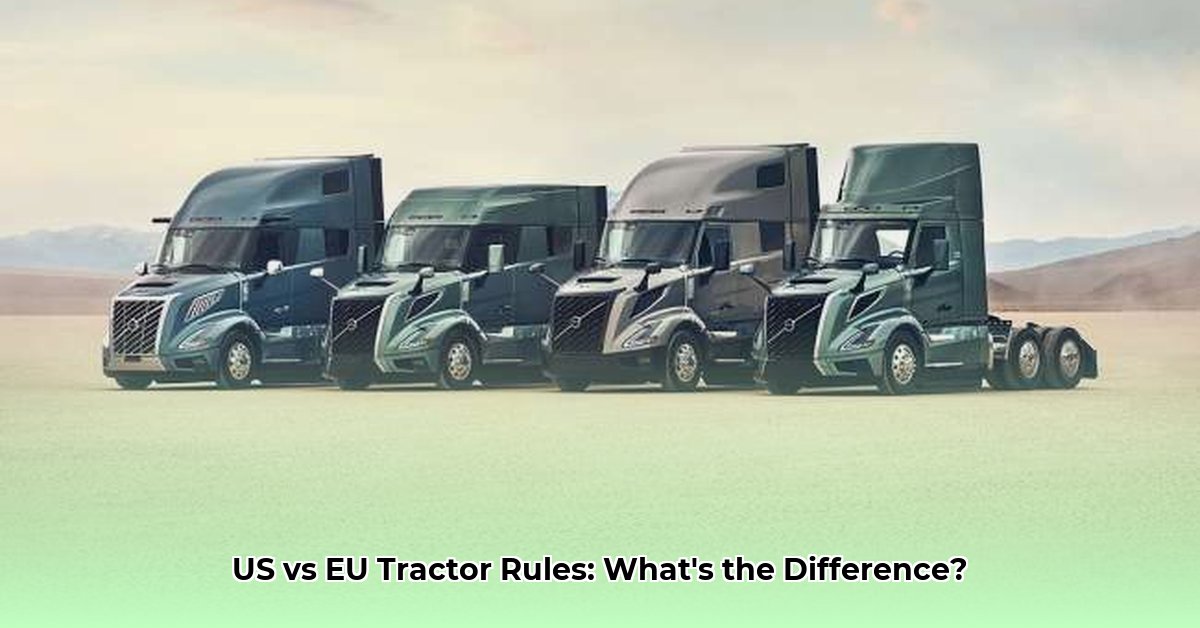
Class 8 Tractor: A Deep Dive into US and EU Regulations
Heavy-duty trucks, also known as Class 8 tractors in the US, are essential for long-haul transportation. However, navigating the regulatory landscape for these vehicles differs significantly between the US and the EU. This guide clarifies the key distinctions, offering practical insights for efficient and compliant operations. For more on heavy equipment manufacturing, see information on tractor production.
GVWR: Understanding Weight Classifications
Both the US and EU utilize Gross Vehicle Weight Rating (GVWR) – the combined weight of the truck and its load – for classification. However, the weight thresholds defining each class vary considerably. In the US, a Class 8 tractor exceeds 33,000 pounds (14,969 kg). The EU lacks a direct Class 8 equivalent. Instead, licensing categories (B, C1, C, CE, etc.) consider not only GVWR but also trailer weight and passenger capacity. A US Class 8 equivalent would likely fall under categories C or CE, but precise weight limits fluctuate across EU member states.
Rhetorical Question: Given the disparity in weight classifications, how can businesses ensure seamless cross-border operations for Class 8-equivalent vehicles?
Quantifiable Fact: A US Class 8 tractor typically requires a Commercial Driver's License (CDL), while EU equivalents necessitate a C or CE license—the specific requirements varying by nation.
Expert Quote: "The lack of a direct Class 8 equivalent in the EU necessitates a more granular approach to regulatory compliance," states Dr. Anya Sharma, Logistics Professor at the University of Transportation Management, explaining the challenges of harmonizing regulations between the US and EU.
Licensing and Operational Requirements: A Transatlantic Comparison
The differing weight classifications necessitate distinct licensing procedures. In the US, a Commercial Driver's License (CDL) is mandatory for Class 8 tractors, often requiring additional endorsements for hazardous materials or specific cargo. Similarly, the EU mandates a C or CE license for comparable vehicles, with stipulations variable depending on national regulations, total weight, and cargo type. International trucking necessitates meticulous verification of licensing prerequisites in each country.
Rhetorical Question: Does the inconsistent approach to licensing across the EU pose a barrier to efficient cross-border freight transport?
Quantifiable Fact: The US CDL system, while complex, provides a standardized framework across states, in contrast with the EU's varied national requirements.
Expert Quote: "International trucking companies must invest heavily in driver training to ensure compliance across multiple jurisdictions," notes Mr. David Miller, CEO of Global Logistics Solutions, Inc.
Straight Trucks vs. Tractor-Trailers: Classification Nuances
The US system distinguishes between single-unit trucks (straight trucks) and tractor-trailers within each weight class. The EU's approach is less precise, resulting in potentially different classifications for identical vehicles depending on the jurisdiction. A US Class 8 tractor typically refers to a tractor-trailer; however, a similarly heavy single-unit truck would receive a different classification in the US, potentially aligning with a similar weight category under EU regulations.
Navigating the Regulatory Maze: A Practical Guide
Successfully navigating international trucking regulations for Class 8 equivalents requires a multi-faceted approach.
Comprehensive Regulatory Research: Conduct thorough research on GVWR regulations for every country on your trucking route. Assumptions are unacceptable.
Driver Training and Licensing: Ensure drivers possess the correct licenses and receive training specific to the vehicle type and regulations of every location.
Leveraging Technology: Utilize GPS tracking, electronic logging devices (ELDs), and weight management systems to streamline compliance.
Continuous Monitoring and Adaptation: Stay updated on regulatory changes, industry best practices, and technological advancements.
US vs. EU Heavy-Duty Truck Classifications: A Comparison Table
| Feature | US Classification | EU Classification |
|---|---|---|
| Primary Criterion | GVWR (Gross Vehicle Weight Rating) | GVWR, Trailer Weight, Passenger Capacity |
| Class 8 Equivalent | GVWR > 33,000 lbs (14,969 kg) | C or CE categories (specific weights vary widely) |
| Licensing | Commercial Driver's License (CDL), often with endorsements | C or CE license (nationally variable requirements) |
| Operational Rules | Varies by state and federal regulations | Varies by nation and EU-wide regulations |
The global Class 8 tractor market is extensive; however, national regulatory differences present significant complexities. This comprehensive guide provides an overview; however, the regulatory landscape is dynamic. Staying informed and utilizing expert advice is critical for sustained success in this intricate field.